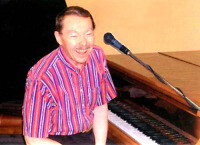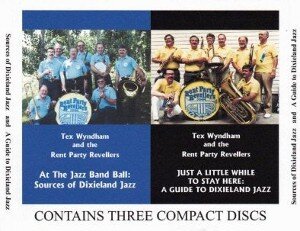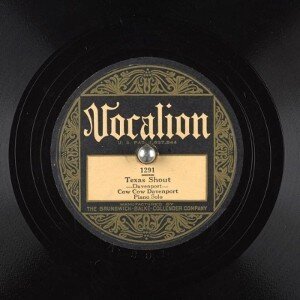 Set forth below is the forty-eighth “Texas Shout” column. The concluding installment of a two-part essay (here’s part 1), it first appeared in the March 1994 issue of the West Coast Rag, now known as The Syncopated Times.
Set forth below is the forty-eighth “Texas Shout” column. The concluding installment of a two-part essay (here’s part 1), it first appeared in the March 1994 issue of the West Coast Rag, now known as The Syncopated Times.
The following note was added to a reprint that ran in May 1999
The text has not been updated. However, at the end of this column, I will add some comments regarding the more recent scene. I can tell you in advance, though, that they will do nothing to change the outlook as it is painted below.
I also deleted from this reprint the last eleven paragraphs of the original article, which discussed some possible ways of dealing with the problems discussed therein. I have done so because (1) the text is already on the longish side and (2) as you will discover from the discussion in the afterward, I am now certain that these ideas would not produce the desired result.
Let’s suppose that I’m right in my guesstimate, and that two-thirds of the Dixieland audience is over 60. The four surveys all show a dramatic fall-off going from ages 60-69 to 70 and over, probably because infirmity, or the grimmer ravages of time, begin taking a toll in earnest as people go from their sixties to their seventies.
Thus, to put it bluntly, we are going to lose a significant proportion of our audience over the next ten years. Even an optimistic reading of the four surveys indicates that the loss is likely to be on the order of 15%, if not more.
Most Dixieland festivals and societies work close to a break-even basis. They can’t afford to lose 15% of their attendees. Major changes in the scene are on the horizon.
My prediction is that, ten years from now, Dixieland festivals and societies will have done one of three things: (1) substantially changed emphasis with respect to the type of music they present, (2) substantially reduced the scope of their operations, or (3) folded. You can already see early-warning indications of these developments today.
Back in February 1993, West Coast Rag’s front-page headline asked “Is It Time To Change Direction?” The article observed that attendance was dwindling at some societies and noted festivals that were going into the red.
Some festivals have already changed direction. Sacramento no longer calls itself a “Dixieland Jubilee” and books headliners who have little or nothing to do with Dixieland. On Sacto’s biggest days, its largest venue, the Convention Center, is programmed almost exclusively with non-Dixieland acts or with show bands which may include some Dixielandish licks among their production numbers.
Without naming names, several other festivals, even some that call themselves “Dixieland” festivals, clearly prefer to hire primarily with an eye toward building crowds rather than the style of music being performed. Personally, I have no trouble with their doing so. I think it is inevitable, given the statistics cited above, that if you want to continue to maintain a profitable large-scale festival in the near future and book any Dixieland acts at all, you are going to have to bring in popular non-Dixieland acts or quasi-Dixieland acts to pay the freight.
If you don’t want to do so, you are going to have to cut back drastically. A number of festivals, mostly in the eastern part of the country, are one-stage festivals held in a hotel ballroom that seats, say, 500 people. These festivals stick to Dixieland, staying afloat by hiring three or four organized out-of-town bands at maximum, possibly filling in around the edges with a set or two by a local combo.
Is there anything that can be done to reverse this trend? When discussing this subject, some well-meaning fans have tried to be reassuring by telling me things like “What comes around goes around”.
I appreciate their sincerity and cheerfulness, but such a slogan represents a do-nothing, head-in-the-sand philosophy. It is not true that what comes around goes around. Plenty of obsolete forms of popular music that once were on solid ground are deader than doornails – Victorian parlor ballads, reveries, Indian intermezzos, cakewalks, schottisches, etc. No one thinks they will “come around” again, and they in fact are not going to do so.
If we let nature take its course, Dixieland might well go the way of, say, wooden flute ensembles, being sustained via periodic get-togethers in the homes of a few aficionados, played for the music’s sake alone. Don’t laugh – it could happen.
For example, while I recognize that some performers and composers are still able to get a significant part of their incomes from ragtime, in some respects ragtime (a music many WCR readers love, myself included) is not far from that status today. Today’s ragtime societies rarely present concerts at which the artists are paid.
They typically meet periodically at a central location, sometimes a member’s home, where ragtimers from beginners to professionals play without pay for each other. Even major ragtime festivals usually have several performers on the bill whose fees do not begin to cover their expenses for the event or who may be appearing without a fee essentially for a place on the program and a chance to stay in touch with the ragtime community.
Further, we are kidding ourselves if we think that, once people reach age 40 or 50, their tastes will mature and they will come to appreciate the merits (which seem so obvious to us) of Dixieland jazz. The crowds cheering Frankie Laine and the Ink Spots at Sacramento did not, by and large, leave the room to catch the Dixieland bands, becoming hooked on our music and seeking out the local Dixieland society. They went back home and listened to their Frankie Laine and Ink Spots records.
Along those lines, following WCR’s “Change Direction” article cited above, “The Letter Drop” contained some follow-up letters expressing sentiments to the effect that Dixieland jazz will remain popular as long as folks like to dance and have a good time, or that as long as Dixieland jazz is fun and exciting, people will pay to see it. I wish it were so, but I can’t agree.
That’s because your conditioning plays such a large part in shaping your definition of a good time. I suppose that folks in Tasmania or Tibet like to dance and have a good time, and enjoy fun and excitement, but that doesn’t mean there is a pent-up demand for Dixieland in those locales. My daughter spent many evenings during her early twenties at discos dancing and having a good time until all hours, but no Dixieland was played there (nor, despite her lifelong association with Dixieland through me, did she bring her friends to Dixieland gigs).
I got out of high school in 1954, just when early rock ‘n roll, which was in those pre-Beatles days a commercialized form of rhythm & blues, was about to take over the hit parade. At my high school dances, we danced mostly box steps to foxtrot rhythm and today have no difficulty dancing to Dixieland (which is played at the tempos of fast, slow and medium foxtrots).
However, while at college in 1955-58, as I sat in my fraternity lodge watching Dick Clark’s “American Bandstand,” I saw the participants dancing to such things as the Twist, the Madison, the Philly Dog and other rhythm steps that go with an early rock ‘n roll shuffle, not a foxtrot beat. If you are between, say, 45 and 55, and your early dancing years were conditioned by “American Bandstand”-type music, you are not going to feel comfortable dancing to Dixieland no matter how well played.
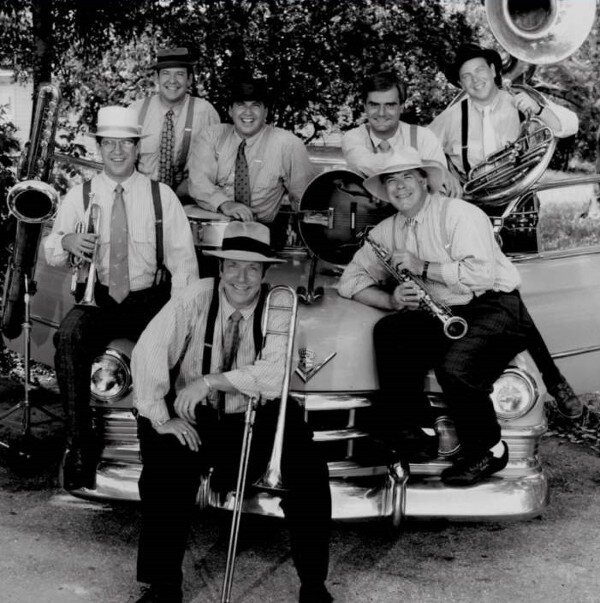 In that connection, look at what happened when Uncle Yoke’s Black Dogs burst on the scene. It was the first band to appear at Dixieland festivals that devoted a major part of each show to tunes with a New Orleans rhythm & blues beat.
In that connection, look at what happened when Uncle Yoke’s Black Dogs burst on the scene. It was the first band to appear at Dixieland festivals that devoted a major part of each show to tunes with a New Orleans rhythm & blues beat.
Even after allowing for the fact that the Black Dogs were all superb musicians with impeccable credentials as Dixielanders and an infectious sense of showmanship, they took the audience by storm compared to other bands with comparably skilled sidemen and presentations. Why?
I saw the answer the first time I heard the Black Dogs do Huey “Piano” Smith’s old hit “Don’t You Just Know It”. As Tom Hook shouted the call, I realized that nearly everyone in the audience knew the tune and was singing the response. These were folks relating to the beat that fueled the hits of Fats Domino and Little Richard, the tunes to which they grew up and danced, with which they felt much more at home than the Dixieland numbers on the Black Dogs’ program.
Now I’m starting to see other bands turning up at festivals with some 1950s New Orleans rhythm & blues tunes in their books. The audiences are responding strongly to such material, even when it is rendered by combos that, to put it kindly, are less talented than the Black Dogs. I can even think of one group that, in my view, has become popular out of all proportion to its musical merits primarily because of its adoption of an approach that takes closer aim at post-1954 pop styles than at Dixieland or any other kind of jazz.
I believe that, as folks in their forties mature into their fifties and sixties, they are likely to bring their music along with them, not adopt ours. Unless we do something to get them refocused, these good people will naturally gravitate toward bands that incorporate more modern elements into their shows, as did the Black Dogs.
If we need a younger audience, what can we do to attract it? Several Dixieland societies in recent years have been sponsoring jazz assemblies in the schools. Some, like the Sacramento Dixieland Society, have gone further, maintaining instructional sessions to teach youngsters to play our music. These are laudable efforts to reach people while their musical tastes are still being formulated.
I support such activities 100%, if for no other reason than my belief that the schools should be exposing children to all aspects of our nation’s cultural heritage, in which Dixieland jazz looms large. However, in terms of attracting the audience needed to replace those disappearing at the older end of the scale, they do not appear to me to be successful.
Although these programs haven’t been going on for a real long time, they have been running long enough to have exposed several years of students to the music. As far as I can see, these youngsters have not graduated from school and elected to join local Dixieland societies or to attend Dixieland festivals in any numbers that are likely to make a difference on the scene.
The exceptions are those who have been taught to play the music, and thereby are getting more immediate and direct rewards therefrom. I am seeing graduates of the Dixieland instructional programs showing up at societies and at festivals, as well as on stages as performers. However, we are not attracting others of their age who simply want to listen.
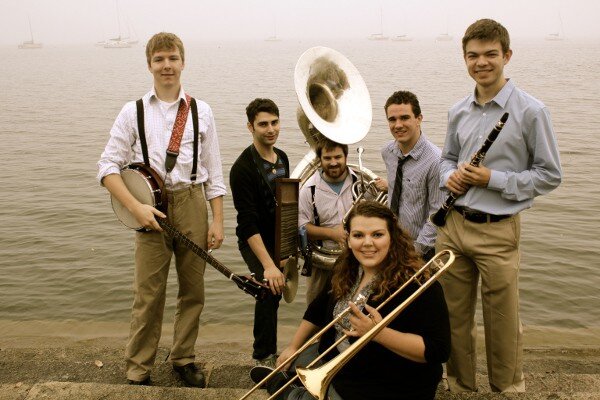
I dealt at length in this column in April 1991 with the musical reasons why young people (i.e., anyone whose musical tastes were primarily conditioned by the post-1950s pop charts) have difficulty relating to Dixieland jazz. Space prohibits me from going through that reasoning here, but let me give you an example that may illustrate why the in-school programs are not bringing more of a young audience to the Dixieland scene.
Suppose you were a youngster who, once a year during your school days, was treated to an assembly in which a band demonstrated Japanese Kabuki music. Do you think you would, through that exposure, have sought out Kabuki records or performances when you graduated and were on your own? Not likely.
We face a similar problem with our youth. The type of “music” prevalent on pop charts today, if it operates according to any rules at all, utilizes conventions so different from Dixieland and other pre-rock styles that they might as well be Japanese Kabuki music as far as youngsters are concerned.
Not long ago, I played a gig in which a member of the band was in his thirties, a solid Dixieland player with a number of recordings and festival appearances to his credit. During a break, he was chatting with Nancy at our table about the scene.
She told me that, after looking around at the white-haired folks comprising essentially all of the audience, he expressed concern that people his age were not on hand. He not only missed having his friends and contemporaries in the crowd (particularly women his age, to pinpoint his exact concern), but also was clearly wondering whether, in ten or twenty years, there’d be anyone left to listen to him. Good question.
* * * * *
Looking back over the above two-part column, as I prepare it for reprinting, I believe that I should tell you how things have progressed in the meantime. We are now well over halfway toward the ten-year point I mentioned in the opening paragraphs above. From here, it looks like my prediction was right on the money.
Yes, I know that you can cite a few festivals that concentrate heavily on Dixieland and which seem to be getting by. In most cases, they are smaller regional ones that primarily hire bands within driving distance.
Yes, I know that there are some combos with weekly or monthly nightspot dates that seem to have a significant number of attendees from the under-60 set. Often, particularly with the twenty-somethings, these are people who frequent taverns or restaurants conveniently located to them and who do not otherwise seek out our music or buy its records. If the band moves to another, less convenient location, they won’t go along. Instead, they’ll patronize whatever group takes over the gig.
Yes, I know that you have seen a 35-year-old playing tailgate trombone somewhere or a teenage banjoist. The plain fact is, though, that the concentrated efforts – jazz camps, free downtown concerts, various other types of publicity, school concerts – by Dixieland societies during the last decade to interest those under 60 in our music have been failures in the sense that such people are not showing up in anywhere near the numbers needed to stem the sharp decline in dedicated Dixielanders.
Anyone with eyes can see that the audience at Dixieland concerts, festival and societies these days is pretty much made up of the remaining ambulatory folks from the attendees at those events thirty years ago. Their average age is now obviously no younger than early-to-mid-70s.
It is equally clear that, with few exceptions, nothing that depends heavily on Dixieland is commercially successful. The 1990s marked the first decade in the last half-century in which no significant new U.S. record label appeared that was devoted to Dixieland. The pages of The American Rag not only regularly report financial losses at this or that society or festival, but also display ads for formerly all-Dixieland festivals that now hire lineups in which little or no Dixieland is included.
Within the past several months, I’ve seen or heard reports of long-standing Dixieland and ragtime festivals that have folded or changed dates/locations because the hotels involved no longer want to be filled up with older folks who don’t eat, drink or otherwise spend much. One of the leading periodicals concentrating on our music disclosed that, for the first time ever, it suffered a significant year-to-year decline in average monthly subscriptions.
Are “comebacks” of Dixieland controlled by Fate on some kind of mystical recurring or cyclical basis? Well, the music first hit the mass market with the release of the initial jazz recordings in early 1917. It enjoyed a revival about fifteen years later, in the early 1940s, spearheaded by the recordings of Lu Watters’ Yerba Buena Jazz Band and Bunk Johnson’s groups. In another fifteen years, around the mid-1950s, a second surge of interest occurred, probably fueled by the replacement (in the adult market) of 78 rpm recordings with LPs. (Teens and younger children bought 45 rpm EP singles instead of LPs.)
However, in the forty-plus years since The Beatles and heavy metal took over the pop charts, there has not been one instance of even a short-lived tiny blip of a “comeback” for Dixieland jazz. Instead, the scene has steadily deteriorated to the point where, as I see it, we are just about at the end of the string.
I am now convinced that there is no way that Dixieland can be made to pay its way anymore. My advice to the remaining Dixielanders reading this column is to make an extra effort to enjoy what’s still around while it lasts.
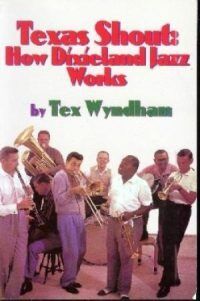 Want to read ahead? Buy the book!
Want to read ahead? Buy the book!
The full run of “Texas Shout” has been collected into a lavishly illustrated trade paperback entitled Texas Shout: How Dixieland Jazz Works. This book is available @ $20.00 plus $2.95 shipping from Tex Wyndham, On request, Tex will autograph the book and add a personalized note (be sure to tell him to whom the note should be addressed).
Tex Wyndham’s 3 CD Guide to Dixieland with music and commentary is available for $20 plus $2.95 shipping. The separate CD, A History of Ragtime: Tex Wyndham Live At Santa Rosa, is available for $13.00 plus $2.00 shipping. On request, Tex will autograph the inner sleeve and add a personalized note (be sure to tell him to whom the note should be addressed).
Send payment to Tex Wyndham, P.O. Box 831, Mendenhall, PA 19357, Phone (610) 388-6330.
Note: All links, pictures, videos or graphics accompanying the Shouts were added at the discretion of the Syncopated Times editorial staff. They did not accompany the original columns and do not necessarily reflect the opinion of Tex Wyndham.
From roughly 1970-2010, Tex Wyndham was: (1) one of the best-known revivalist Dixieland jazz musicians in the US, as cornetist, pianist and bandleader, (2) one of the best-known ragtime pianists in the US, and (3) one of the most respected critics in the US of Dixieland jazz, ragtime, and related music. He is the only person about whom all three of those statements can be made.

